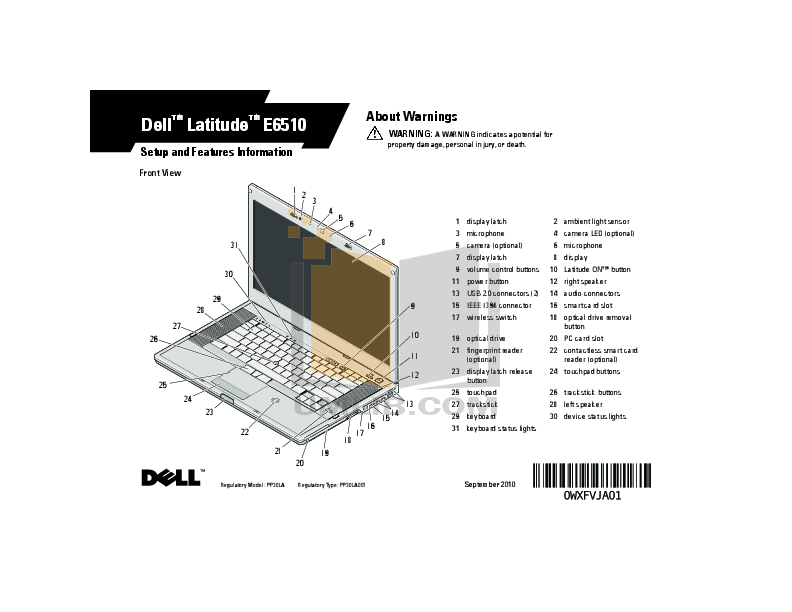View and Download Dell Latitude E6410 setup and features information online. Setup and Features Information Tech Sheet. Latitude E6410 Laptop pdf manual download. Also for: Latitude e6410. Oct 28, 2012 Dell: Latitude E6410 Service Manual Item Preview remove-circle. Dell-manual-latitude-e6410service-manual Identifier-ark ark:/13960/t9x07ch8f Ocr ABBYY FineReader 8.0 Ppi 600. Reviews There are no reviews yet. Be the first one to write a review. DOWNLOAD OPTIONS download 1 file. ABBYY GZ download. Download 1 file.
- Dell Latitude E6410 Laptop Manual
- Dell Latitude E6410 User Manual Download
- Download Latitude E6410 Manual
Parallel Port
Default Setting: ECP
Serial Port
Allows you to configure the integrated serial port. The options are: Disabled, COM1, COM2, COM3, and COM4
Default Setting: COM1
SATA Operation
Allows you to configure the internal SATA hard drive controller. The options are: Disabled, ATA, AHCI, and RAID On
Default Setting: RAID On
Miscellaneous Devices
Allows you to enable or disable the following devices:
l
Internal Modem
l
Module Bay
l
ExpressCard or PC Card
l
Media Card, PC Card and 1394
l
External USB Port
l
Microphone
l
eSATA Ports
l
Hard Drive Free Fall Protection
l
Camera and Microphone
Default setting: All enabled.
Latitude ON™ Reader
Allows you to configure the operating mode of the Latitude ON Reader. The options are: Disabled and Enabled
Default Setting: Enabled
Keyboard Illumination
Allows you to configure the keyboard illumination feature. The options are: Disabled, Auto ALS and Input, and Auto Input
Only
Default Settings: Disabled
Video
Option
Description
Ambient Light Sensor
To enable the Ambient Light Sensor, select the Ambient Light Sensor check box.
Default Settings: Disabled
LCD Brightness
Allows you to set the display brightness depending up on the power source (
On Battery and On AC).
Security
Dell Latitude E6410 Laptop Manual
Option
Description
Admin Password
Allows you to set, change, or delete the administrator (admin) password. When set, the admin password enables several
security features including:
l
Restricts changes to the settings in Setup
l
Restricts the boot devices listed in the <F12> Boot Menu to those enabled in the 'Boot Sequence' field
l
Prohibits changes to the owner and asset tags
l
Substitutes for the system and hard drive password

NOTE: You must set the admin password before you set the system or hard drive password.
NOTE: Successful password changes take effect immediately.
NOTE: Deleting the admin password automatically deletes the system password as well.
Default Setting: Not Set
System Password
Allows you to set, change, or delete the system password. When set, your computer requests you to enter the system
password every time your computer turns on or restarts.
NOTE: Successful password changes take effect immediately.
Default Setting: Not Set
Internal HDD Password
This field lets you set, change, or delete the password on the system's internal hard disk drive (HDD). Successful changes take
place immediately and require a system restart. The HDD password travels with the hard drive, so the HDD is protected even
when installed in another system.
Default Setting: Not Set
Password Bypass
Allows you to bypass the system and internal hard drive password prompts when your computer restarts or resumes from
standby.
You can set Password Bypass to Disabled and Reboot Bypass.
NOTE: You cannot bypass the system or hard drive password when you turn on your computer that has been shut down.
Default Setting: Disabled
Password Change

Allows you to enable the disable permission to the System and Hard Drive passwords when the admin password is set.
Default Setting: Allow Non-Admin Password Changes checked
Strong Password
Allows you to enable of disable option to enforce strong passwords. If enabled, all passwords set on the computer must
contain at least one uppercase character, one lowercase character and be at least 8 characters long. Enabling this feature
automatically changes the default minimum password length to 8 characters.
Default Setting: Disabled
Allows you to enable or disable the Trusted Platform Module (TPM) on the computer.
NOTE: Disabling this option does not change any settings you may have made to the TPM, or delete any information or keys
you may have stored there.

Dell™ Latitude™ E6410/E6410 ATG Service Manual
Notes, Cautions, and Warnings
If you purchased a Dell™ n Series computer, any references in this document to Microsoft®
Windows® operating systems are not applicable.
Information in this document is subject to change without notice.
© 2010 Dell Inc. All rights reserved.
Reproduction of this material in any manner whatsoever without the written permission of Dell Inc. is strictly forbidden.
Trademarks used in this text: Dell, the DELL logo, Latitude ON, and Latitude are trademarks of Dell Inc.; Intel, Pentium, Celeron, Intel SpeedStep, Intel TurboBoost, and Core are either
trademarks or registered trademarks of Intel Corporation; Bluetooth is a registered trademark owned by Bluetooth SIG, Inc. and is used by Dell under license; Microsoft, Windows,
Windows Vista,and the Windows Vista start buttonare either trademarks or registered trademarks of Microsoft Corporation in the United States and/or other countries; Adobe, the
Adobe logo, and Flash are either registered trademarks or trademarks of Adobe Systems Incorporated in the United States and/or other countries; ATI FirePro is a trademark of
Advanced Micro Devices, Inc.
Other trademarks and trade names may be used in this document to refer to either the entities claiming the marks and names or their products. Dell Inc. disclaims any
proprietary interest in trademarks and trade names other than its own.
June 2010 Rev. A00
Working on Your Computer
Removing and Replacing Parts
Specifications
Diagnostics
System Setup
NOTE:
Dell Latitude E6410 User Manual Download
A NOTE indicates important information that helps you make better use of your computer.
Download Latitude E6410 Manual
CAUTION:
A CAUTION indicates potential damage to hardware or loss of data if instructions are not followed.
WARNING:
A WARNING indicates a potential for property damage, personal injury, or death.